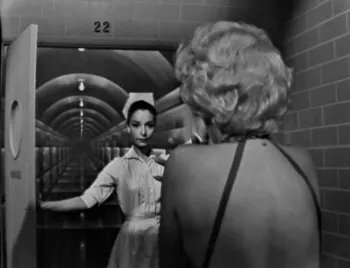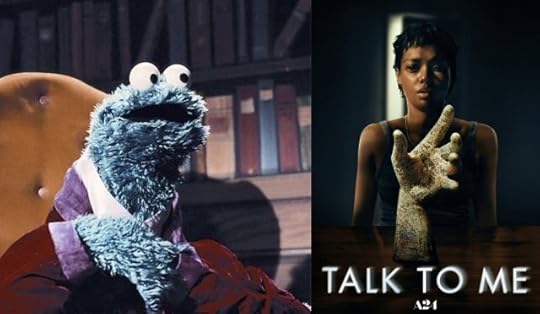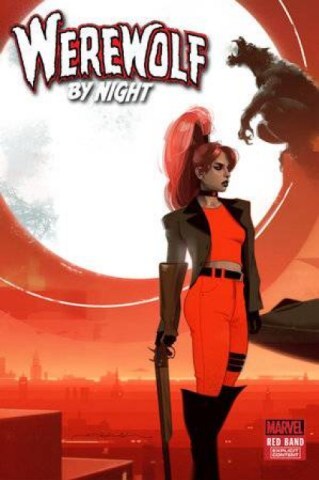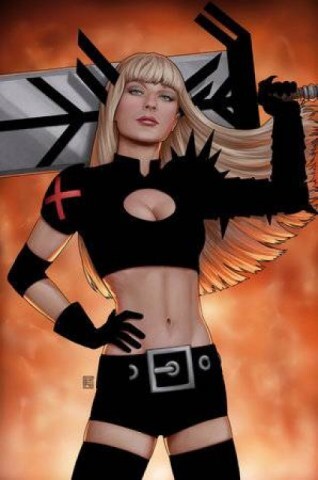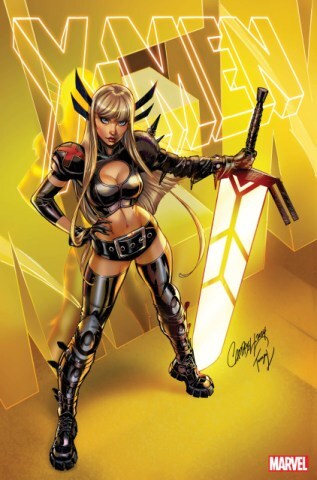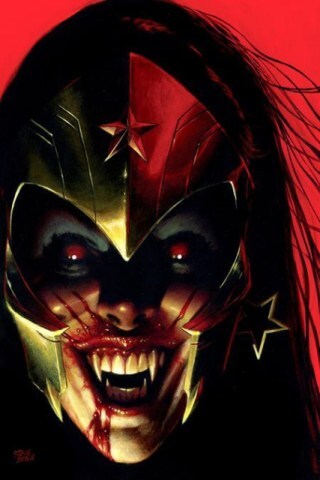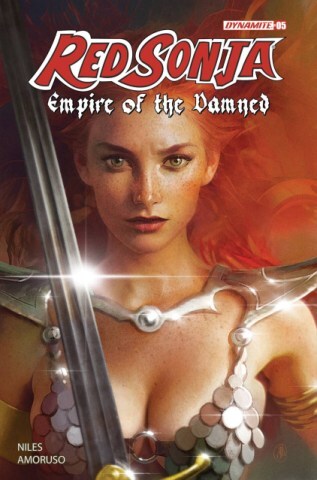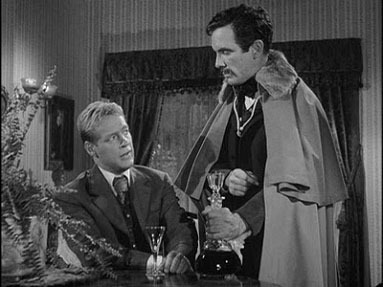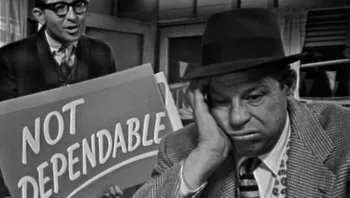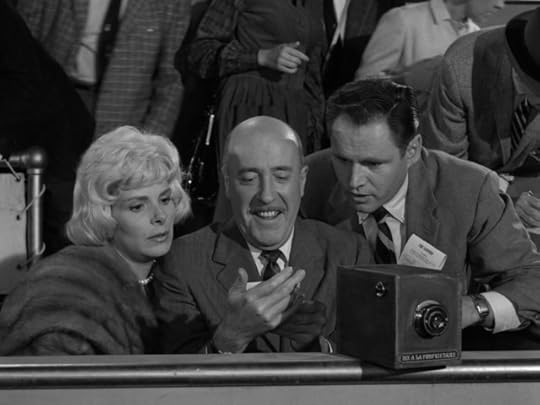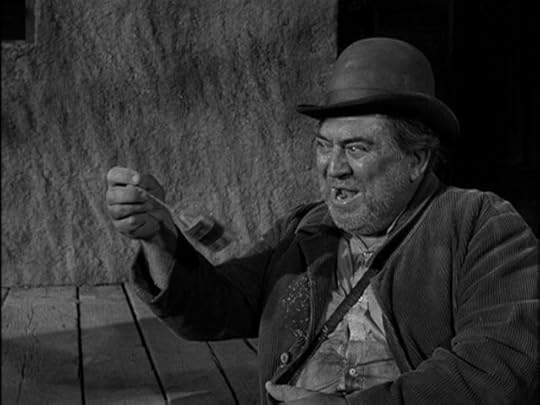Joseph Mallozzi's Blog, page 45
August 19, 2024
August 19, 2024: Recent Yes/No’s – Best and Worst!

BEST: Revani
WORST: Cheese bacon potato pie
The post August 19, 2024: Recent Yes/No’s – Best and Worst! appeared first on Joseph Mallozzi's Weblog.
August 18, 2024
August 18, 2024: Sharky Sunday!
Rare video of Sharky actually playing with a toy….

Sharky enjoys some mackerel…

Here’s the kicker…

Bicycle…

It’s like he’s trying to tell us something…but what?

The post August 18, 2024: Sharky Sunday! appeared first on Joseph Mallozzi's Weblog.
August 17, 2024
August 17, 2024: The Twilight rewatch continues with season 2, episodes 17-20!
Season 2, Episode 17, “Twenty Two”
This episode was first broadcast February 10, 1961.
Rod Serling drew his inspiration for this episode from “The Bus Conductor” by E.F. Benson which also inspired a segment in the horror film anthology Dead of Night. He was also partly inspired by a newspaper article about a construction worker who seemingly foretold his own death, informing co-workers he would be dead within days and then dying following a construction accident involving a crane.
Actress Barbara Nichols accidentally fell when she was running down the airplane steps and director Jack Smight liked it so much, he kept it in the cut. Nichols apparently suffered cuts and bruises to her knees and was thankful she wasn’t asked to do another take.
This was the fourth of six episodes shot on video.
This episode was purportedly the inspiration for Final Destination (2000).
Barbara Nichols, who played the seemingly doomed Liz Powell, built a career as a model, pin-up girl, and playing roles as dancers and wise-cracking supporting players. The Twilight Zone was a welcome change for her. According to Nichols: “I told Mr. Sterling I’m always a comedienne. I told him I’d always wanted to do dramatic roles. So he wrote the show for me. I’m happy as a clam.”
Nichols was involved in two serious car accidents, the first of which necessitated the removal of her spleen and the second of which resulted in a tear in her liver that, in turn, led to liver disease and her death at the all-too-young age of 48.
Jonathan Harris, who played the cackling doctor, trained himself to lose his New York accent early in life, learning to speak in the eloquent manner that served him well throughout a career peppered with polished villains, chiefest among them Dr. Zachary Smith in Lost in Space (1965). He beat out both Jack Elam and Carroll O’Connor for the role. Although his character was only meant to appear in five episodes, he proved so popular that he ended up sticking around for the show’s entire run. While he remained good friends with series regular Bill Mumy, he never had the best of relationships with actor Guy Williams who played his adversary on the show.
Harris made many convention appearances following the show’s cancellation, often requesting his booth or table be separate from the other cast members.
Actress Arlene Martel, who played the creepy nurse, is perhaps best known to genre fans as T’Pring in “Amok Time” from the original Star Trek (1967). Apparently, her vulcan make-up and her sinister make-up for this episode were virtually identical.
I was not a big fan of much of this episode and its bargain basement video visuals. There were a number of odd/bad choices like the doctor’s annoying cackle or that unbearably stagey moment where the doctor pulls away the curtain to reveal the nurse standing behind it. And then there’s moment where, at the airport, she bumps into a woman who drops her vase, glances down blankly, and just leaves. What the hell was the point of that?
But having said all that, I really did love the final five minutes which saved this episode for me. Not a Top 10 entry but, in the end, not a bad outing.
Season 2, Episode 18, “The Odyssey of Flight 33”
This episode was first broadcast February 24, 1961.
Rod Serling was inspired to write this episode after receiving a brochure for a Boeing 707 cockpit interior that had been used for stewardess training and was available for production rental.
Rod’s brother, Robert Serling, was an airline pilot and aviation writer for United Press International and is credited as a consultant on this episode as he provided much of the authentic pilot dialogue.
Douglas Heyes was scheduled to direct this episode but, for some reason, was swapped out at the last minute for Justus Addiss. Heyes would never direct another episode of the series.
The brontosaurus sequence was credited to Jack N. Harris. A model was built and later used in Dinosaurs (1960). The sequence cost the production $2500, making it the most expensive footage in the show’s run.
Stephen King used elements of this plot for The Langoliers (1990).
In the previous episode, the protagonist fears room 22 and almost boards the ill-fated flight 22. In this episode, the plane’s occupants end up 22 years in the past and are asked to land on runway 22.
Serling was accused of plagiarism by someone who had sent in a story idea they felt was similar. Serling wrote back “neither the situations, the characters, the story projection or the conclusion have even the remotest similarity. I find it diffiuclt to understand or, indeed, am I able to figure out just what “coincidences” you’re referring to. In my view, these two stories share not one thing in common. […] At least fifteen letter writers each month accuse us of stealing story material from them.” Then, he goes on to add something that pretty much sums up why writers don’t read unsolicited ideas or scripts: “Frankly, it has become impractical to even open up manuscripts because the process carries with it the built-in possibility of having to respond to often violent accusations and with it, the added inconvenience of having to devote time trying to explain to the letter writer that we are a legitimate production unit who have enought trouble getting a show on the air without having to spend the time answering correspondence.” Not to mention the potential legal ramifications.
The accuser submitted 20 plot ideas through his agent. One, “Ah, Youth!”, ended up being purchased, apparently to avoid any legal entanglements. It became the season 5 episode “A Short Drink from a Certain Fountain”.
Actor John Anderson, who played the part of Captain “Skipper” Farver may look familiar because he played the role of Gabriel in season 1’s “A Passage for Trumpet”. He played Abraham Lincoln three times on screen as well as Kevin Uxbridge on Star Trek: The Next Generation’s “Survivors”, and MacGyver’s grandfather.
Reflecting back on shooting this episode, Anderson said: “We looked damn serious doing that show, but we had a blast filming that. The guys playing my co-pilots were great. The director had trouble getting us settled because we were having so much fun. When you see me looking out at the dinosaur, I’m really looking at the the poor director. As soon as he’d yell, “Cut”, we were cracking jokes again. We were confined in this little cockpit. Whenever the director said “There’s a dinosaur” we had to pretend that it was out there. I saw the episode recently, and I was amazed I was able to spew out that technicial goggledygook.”
Actress Betty Garded, who played the chatty passenger, would later return in season 3’s “The Midnight Sun” as Mrs. Bronson, an overwrought landlady.
Actor Jay Overholts, who played the passenger on the receiving end of her diatribe, is credited with the most Twilight Zone guest appearances at eight.
Love the premise and, while the dinosaur footage feels humorously dated, I thought it was a pretty strong episode. I thought it would have benefited by our getting to know the passengers or maybe exploring the reactions of those not in the cockpit but, all in all, a solid outing.
Season 2, Episode 19, “Mr. Dingle, the Strong”
This episode was first broadcast March 3, 1961.
The street exterior where Mr. Dingle throws the football was last seen in season 1’s “The Monsters Are Due on Maple Street”.
This episode marked the second of Burgess Meredith’s four Twilight Zone appearances. His previous guest turn was in the seminal “Time Enough at Last”.
Don Rickles, who played the bullying bettor in this episode, got his start working nightclubs before landing his first role in Run Silen, Run Deep (1958). The movie was a hit and kick-started his onscreen career. The acerbic comedian was a regular on the Dean Martin Celebrity Roasts and starred in his own short-lived series, CPO Sharkey (1976). He voiced Mr. Potato Head in the first two Toy Story movies.
Nicknamed “Mr. Warmth” by Johnn Carson, Rickles never wrote down his jokes, preferring to come up with them on the spot. He became known as an insult comedian after resonding to a heckler at one of his shows and noticing the audience responded better to his comebacks than his actual show.
On April 6, 1972, mob boss Joe Gallo took in Rickles’ show at the Copacabana in New York. Rickles didn’t hold back, sending a few insults his way. Gallo was so amused that he invited Rickles to join him for dinner after the show. Rickles politely declined. And a good thing he did because Gallo was gunned down by hit men at the restaurant later that night.
Asked to provide some one-liners by the show’s publicity department, Rickles offered the following:
“Serling must do well. I’ve seen him in a convertible space ship.”
“The producer of Twilight Zone liked my work so well he gave me a summer home on Venus.”
“Serling is a brilliant writer – I know this because he gave me a card that said “brilliant writer” in color.”
Rickles reflected back on his time on the show: “Screw the director. I don’t even recall who directed that. The main man I remember was Burgess Meredith. He was one of the greats. I’m telling you he played his part so well that Rod Serling is probably shaking his hand to this day. That alien thing was stupid but what the heck, that was The Twilight Zone. You know what I remember about Meredith? In between takes he was a warm fellow who had a great sense of humor. We shot jabs at each other and he took ‘em as fast as he pitched them. They don’t make men like him anymore.”
Actor James Millhollin, who played the t.v. host, appeared in three episodes of The Twilight Zone, and previously as Mr. Arbruster in “The After Hours”.
This episode would mark actor Douglas Spencer’s (Martian #1) final role. He passed away of diabetes-related complications seven months after the episode aired.
Michael Fox, who played Martian #2, in discussing his work on the show: “I did a few of those. The one that I’m remembered for was the one where I played half of a two-headed monster and that was delightful. I got to know Serling fairly well – he was a charming and most talented man, and one of the few writers who really understood an actor’s problems, I thought.”
I enjoyed the previous comic episode (written by George Clayton Johnson) because the humor was restrained and character-focused, but Serling’s comedy leans into the broad, the silly, and the over-the-top. Not a fan of this one and especially not a fan of the alien designs that, I get it, are dated and intentionally silly, but even so…
Season 2, Episode 20, “Static”
This episode was first broadcast March 10, 1961.
This was the third of Charles Beaumont’s five scripts for the show and the fifth of six episodes shot on video. It was based on the Ocee Ritch story “Tune in Yesterday”.
A gentleman by the name of Fred DeGroter claimed the episode ripped off his story submission “Radio”, and threatened legal action…that went nowhere.
CBS disapproved of the line “Go buy yourself a switchblade” and asked it to be switched to candy or a remote-control toy. Serling ignored the request.
FDR’s address to the nation Ed Lindsay listens to was the first of his presidential fireside chats.
One of the scenes displays a commercial for chlorophyll cigarettes, a parody of the Chlorophyll Rage that saw companies hawking everything chlorphyll cigarettes to chlorophyll-laced toothpaste.
Actor Dean Jagger, who played the morose and perenially-sour Ed Lindsay, apparently spoke with a lisp in real life which disappeared when he was onscreen. He supported Senator Joseph McCarthy’s investigation into possible communist sympathizers in Hollywood and successfully lobbied to have blacklisted director Joseph Losey replaced on “X – The Unknown”, a British science-fiction film he starred in in 1956.
Alice Pierson, who played Mrs. Nelson, was a commedienne on stage and screen. Her final role was her most revered, that of nosy neighbor Gladys Kravitz on Bewitched (1964). Only two seasons into the show, Pierson died of ovarian cancer, two weeks after shooting her final episode. She won a posthumous Emmy for her performance. Series star Elizabeth Montgomery and husband/producer William Asher helped her husband, Paul Davis, land a directing gig on the show as he had given up his broadway directing career to look after his ailing wife.
Stephen Talbot, who played the hip young boy, was a child actor who transitioned to documenary film-making, producing many critically-acclaimed pieces for PBS’s Frontline (1992).
This episode marked the first onscreen role for then radio disc jockey Bob Crane who goes uncredited here as the radio disc jockey.
After playing the role of Dr. Dave Kelsey on The Donna Summers Show (1958) for two seasons, Cranee was let go by producers who considered his character “too suggestive”. He eventually landed the role that made him famous, playing the part of series lead Colonel Hogan on Hogan’s Heroes (1965) for which he received two Emmy nominations. While on the show, he divorced his wife of twenty years to marry his series co-star Sigrid Valdis who payed Colonel Klink’s secretary, Hilda.
Following the cancellation of Hogan’s Heroes, opportunities were fewer. In 1975, he headlined his own series, The Bob Crane Show that only lasted a single season.
Three years later, while touring with the play “Beginner’s Luck”, Crane was found dead in an apartment in Scottsdale, Arizona. He had been beaten death and strangled (post-mortem) with an electric cord. His murder was never solved. Crane was good friends with actor Carroll O’Connor (All in the Family), who was a pallbearer at Crane’s funeral.
Some critics feel the episodes that take place on interior sets don’t suffer as greatly from the drop-off in visual (and, in the case of this episode, audio) quality as a result of them being shot on video, but I would disagree as they come across to me as exceedingly cheap-looking, akin to early 1950’s soaps.
“Static” was pretty drab and dismal all-around. Our protagonist, Ed Lindsay, was an antiquated asshole whose incessant grousing just got to be too much for me. While several past Twilight Zone episodes have offered ambiguous endings, this one felt like it was simply slapped on, a TZ-esque-like conclusion that doesn’t really land.
The post August 17, 2024: The Twilight rewatch continues with season 2, episodes 17-20! appeared first on Joseph Mallozzi's Weblog.
August 16, 2024
August 16, 2024: Cookie monster movie review – Talk to Me!
Monster not a fan of seances. Once, me go to place where everyone gather, turn off lights and get very quiet. Monster’s fur rise on neck and me could feel evil energy in room as we wait for spirit to show up. Waiting in darkness. Waiting in silence. Waiting. Waiting. Waiting so long Monster tink it all for nothing and den, suddenly, spirit appear and everyone shout and spirit shriek and Monster scream and trow Holy Water on spirit to cast it back to Hell. Except it turn out not Holy Water, but akutally a Negroni. And not spirit but, but akutally owner of apartment, Noreen. Also, not seance but aktually surprise party.
Anyway, dat experience scar Montster emotionally partly becuz me get slightly sued for pulling spirit-Noreen around room by her hair shouting “Demon begone!!”, so dis movie very scary for Monster.
It offer a new spin on seance involving teens, social media, and severed forearm dat look suspiciously like petrified remains of Cousin It from old Addams Family series. Rules of seance are simple: 1) Touch hand and say “Talk to me” to see ghost. 2) Say “I let you in” to be possessed by ghost. 3) Sever contact to spirit world by taking hand away and blowing out candle. 4) Clear room of residual evil energy by playing video of celebrities singing Imagine (note: Even spirit-demons tired of Will Ferrell).
And of course tings go perfectly fine until tings go horribly wrong.
Monster love de set-up and find movie veeeeery creepy and compelling – up until last act when it get confusing and main charakter start making stoopid choices. Up to dat point, movie be a thrill ride. After dat, it like going downhill in Grover’s Yugo.
Verdikt: 3.5 out of 5 chocolate chippee cookies.
The post August 16, 2024: Cookie monster movie review – Talk to Me! appeared first on Joseph Mallozzi's Weblog.
August 15, 2024
August 15, 2024: Fourth round of script notes!
Thanks for the fourth draft of your script. Apologies for the delay in responding, but we were addressing an issue on the set of our new movie shooting in the Philippines, a biopic of Don Santiago De Los Santos, the famed 19th century Filipino of short stature. Despite the fact he was only 2 feet, 2 inches tall, Santiago was a master of multiple languages and a popular stage performer who became a huge celebrity in 19th century England. Two days into filming, however, Peter Dinklage complained on social media, so we had to recast. Chris Pratt was brought in to take over the lead role and Hernando, the local little person we originally cast, went back to selling dried tillefish at the Taboan Public Market. Catastrophe averted!
Anyway, on to the notes…
Is there a way to give the FBI and Secret Service characters testifying before Congress some purpose? As things stand, they add nothing to the story. Would it be possible for them to provide the occasional answer to the questions asked rather than obfuscating or hiding behind their stock “We’re still looking into it and will get back to you!” response? Our audience isn’t the Pennysylvania electorate. They require results in a timely manner. At present, the only one providing any real insight is the whistleblower character.
Speaking of which…
The Secret Service lead site agent at the rally demonsrates all the competence of an Australian breakdance champion at the Olympics. Let’s come up with a reason for why they were, according to the whistleblower, “inexperienced”, “inept”, and “did not enforce normal security protocols”. Were they, perhaps, someone with an incurable disease whose final wish was to be a lead site agent for just one day, a wish granted them by the Secret Service? This might explain some – but certainly not all – of the security lapses.
According to the whistleblower, Homeland Security agents, many of whom had no experience working rallies, were primarily responsible for security instead of the Secret Service. Why? Can we say the Secret Service agents were reallly hung over from the night before and had Homeland Security cover for them?
Counter snipers communicated via text without wifi according to the whistleblower. Why not radios? Hell, why not two toilet paper rolls with strings connecting them? Maybe the lack of radios was the result of budget cutbacks? If you like this idea, please specify other ways in which they had to tighten their belts (ie using hand-me-down .300 Winchester Magnum-chambered bolt-action rifles with second hand Schmidt & Bender scopes).
According to the whistleblower, the Secret Service was in a separate command center far from the action. Did that separate command center happen to be…the Arbys’ up the road?
Some here bumped on the FBI being unable to explain why the whistleblower’s email was deleted, but I pointed out that the FBI has a rich history of accidentally deleting crucial emails so I found this beat consistent.
The old adage “Show, don’t tell” is put to curious use in this script. In sworn testimony, the Secret Service Director claims that the the shooter was obscured by the roof so the counter-sniper could not have seen him. Yet, later, we are shown video of the shooter sprinting across the rooftop for all to see! In a similar vein, the body cam footage from law enforcement on the day shows them complaining about the fact they repeatedly asked the Secret Service to secure the warehouse the shooter used, again directly contradicting the Secret Service official’s claims. Given the Secret Service’s inability to perform the most basic of duties, like communicating with law enforcement, is it possible they also failed to communicate with this Secret Service Director who may just be cluelessly uninformed because he just got back from an extended vacation in Aruba?
In scene 67, the Secret Service Director claims local law enforcement was briefed by the Secret Service. Yet in scene 79 the SWAT Team gives a tv interview contradicting this claim, insisting they never had contact with the Secret Service until after the shooting. And haven’t heard from them since. This reads like the Secret Service is trying to cover their asses, but only doing a half-ass job of it.
Slight inconsistency in the logic surrounding the shooting. The counter-sniper, who officially didn’t see the shooter until he opens fire, neutralizes him almost instantly as if…he already knew he was there. Which is it?
Why was no counter-sniper positioned on the water tower, the highest point on the property, as overwatch? Was he afraid of heights?
After not using counter-snipers for two years while running security for the Presidential frontrunner, the Secret Service suddenly decides to make use of them for this particular rally. They claim it was because they believed Iran was seeking to assassinate the frontrunner – but why all of a sudden and not a week, a month, or even a year earlier? Did he do something to further enrage Iran like, say, critiquing their allies in the current administration who granted them sanctions relief? (P.S. I see you still haven’t given up on trying to set up Iran as the Big Bad, this time by pointing the finger at them for the hacking of the Presidential frontrunner’s campaign. Unfortunately, it’s still coming across as clunky and unconvincing. Furthermore, it feels like you’re borrowing story ideas from the last political presidential campaign movie we did, “Russia Hour”, starring Willem Dafoe and Chris Tucker.)
Why has the lead site agent who was responsible for the security debacle not been relieved of duty pending the conclusion of this investigation? This is like a waiter telling diners: “Don’t worry. The chef who killed those people by serving them impromperly cleaned fugu is under investigation. In the meantime, he has made you a lovely fugu appetizer for tonight’s dinner. Enjoy!”
The scene where the Secret Service Director claims they are being unfairly persecuted could use a melancholic music cue. We suggest Samuel Barber’s Adagio for Strings.
Dialogue note! The Secret Service Director blames his department’s shortcomings on “a failure of imagination”. How the hell does that make sense? That is literally their one and only job! How imaginative do they have to be?!
The scene where the Secret Service is finally shamed into providing protection for the presidential candidate running as an independent is also dramatically satisfying.
Once again circling back to why this 20 year old has no social media. And why aren’t the journalists interviewing the shooters friends and/or schoolmates? They seem exceptionally lazy, even by today’s journalistic standards.
Okay – after absorbing the last three drafts and your attempts to plug the seemingly endless plot holes in this script, I think we’re at the point where we must choose to go one of two ways:
1) You can continue writing endless drafts, trying to explain away and excuse the unbelievable gross incompetence displayed by the Secret Service on the day OR
2) You can embrace the more dynamic and logically-sound angle that this was actually… a poorly orchestrated attempt by elements within the government to get rid of a troublesome presidential candidate!
If you go with the latter, then almost all of the elements that currently don’t make sense in your script actually do!
Think about it!
Meanwhile, the presidential campaign backdrop of this script continues to impress. Will the media darling hold a press conference before the election? Will she ever release her platform? Will she be replaced by a mop and handle and still maintain the exact same level of support? We can’t wait to find out!
One logic bump though. She promises to address key issues, yet being part of the current administration actually makes her party to the bad policy decisions that created the issues in the first place. Also, if she’s already in power, why wait to implement these fixes? Am I missing something? Let’s have the media actually push back on this a little and convey a semblance of nonpartisan integrity. To this point, they’ve proven about as impartial as an NBA ref calling a Lakers home game.
P.S. When the time comes we have a terrific casting suggestion for the VP’s VP pick. He looks like a cowardly lion too!
Finally, if you’re going to have her throw out potential policy ideas, make the effort to come up with something original rather than just cribbing from ther opponent’s platform.
Overall, we really like all of the dark authoritiarian beats that continue to loom large, like the use of the justice department to target political rivals and the global crackdown on free speech. Having said that, it has been brought to our attention that these story elements bears some striking similarities to a previously published work. To avoid a potential lawsuit, could you tweak some of these narative elements to differentiate them from George Orwell’s 1984. We don’t want people to think we’re ripping him off.
That’s all for now. Looking forward to reading the rewrite!
The post August 15, 2024: Fourth round of script notes! appeared first on Joseph Mallozzi's Weblog.
August 14, 2024
August 14, 2024: Amazing Covers!
A few that caught my eye this week…
Werewolf By Night: Red Band #1 – cover art by Jeff Dekal
X-Men #1 – cover art by John Tyler Christopher
X-Men #2 – cover art by J. Scott Campbell
DC vs Vampires: World War V #1 – cover art by Steve Beach
Red Sonja: Empire of the Damned #5 – cover art by Joshua Middleton
American Psycho #5 – cover art by Patricia Martin
So, which were YOUR favorites?
The post August 14, 2024: Amazing Covers! appeared first on Joseph Mallozzi's Weblog.
August 13, 2024
August 13, 2024: Our Twilight Zone rewatch continues with season 2, episodes 13-16!
Season 2, Episode 13, “Back There”
This episode was first broadcast January 13, 1961.
Rod Serlihg originally conceived this story as an hour long episode called “Afterwards” that he submitted to Armstrong Circle Theatre, the only one hour anthology airing at the time, but was rejected. His attempts to get it accepted as a special one hour Twiilght Zone also failed, so he ended up adapting it to the half hour format.
Actor Russell Johnson, who played the time-hopping Peter Corrigan, returns for another time-travel-themed episode following his appearance in season 1’s “Execution”.
In the 50’s and 60’s, Johnson found some success playing villains in westerns but, according to him: “You name a Western, I did it. I was always the bad guy in Westerns. I played more bad guys than you can shake a stick at until I played the Professor. Then I couldn’t get a job being a bad guy.” Nevertheless, he was philosophical about this in his later years: “It used to make me upset to be typecast that way. But as the years have gone on, I have given in. I am the Professor, and that’s the way it is. The show has brought a lot of joy to people, and that’s not a bad legacy.”
Actor Paul Hartman, who played the Police Sergeant, was a dancer, vaudevillian and actor. He and his wife won Tony Awards for their “Angel in the Wings”.
Actor Bartlett Robinson, who played the fortuitous William in this episode, returns in “To Serve Man”.
Actor Jimmy Lydon, who portrayed Patrolman James Lydon, gave 15-year-old Elizabeth Taylor her first onscreen kiss in Cynthia (1947). In later years, he was a producer on 77 Sunset Strip and ran his own production company, Spectrum.
Actor Raymond Bailey, who played the inquisitive gentlemen’s club member Millard, tried acting after high school, struck out, and became a stock broker and banker. He tried acting again, stuck out again, and became a seamen, working as a deckhand on a freighter. He tried acting once again and third time was the charm. His career flourished, most notably as the tightwad banker Milton Drysdale on The Beverly Hillbillies where he developed a close friendship with his co-star, Nancy Culp, who he affectionately nicknamed “Slim”.
Whenever I watch time-travel episodes such as these, I can’t imagine being as dumb as the characters in these stories. Rather than trying to convince someone I’m from the future or say “I can’t tell you how I know because you wouldn’t believe me”, I’d just tell them something along the lines of “I overheard a conversation by two strangers at the pub. They were plotting to kill the President at Ford theater in a couple of hours!”. But, granted, that would be too easy. Too logical, and too easy. Alas, I found this one pretty cornball. When he pulled out the embroidered handkerchief with the initials J.W.B. Oof.
Season 2, Episode 14, “The Whole Truth”
This episode was first broadcast January 20, 1961.
The idea for this episode came from the combination of two episodes proposed for the doomed Mr. Bevis show. In one, Bevis was “blessed” with the power of telling the truth for 24 Hours. In another, he was a used car salesman.
In the original script, Krushchev appears to answer questions about how much better America is than the Soviet Union.
Actor Jackson Carson, who played sales shark Harvey Hunnicut, made a career out of playing nice guys with a heart of gold. He got his start doing radio comedy before moving on to film and television. In the 40’s, he would often disappear for weeks at a time and only his wife knew his whereabouts. Turned out he joined a traveling circus and entertained crowds, incognito, as one of the Big Top clowns.
Actor George Chandler, who played the old man who sells Hunnicut the haunted automobile, is better known as Uncle Petrie on Lassie.
Actress Nan Peterson, one half of the car-shopping couple, made four appearances in the Twilight Zone : as a Woman in the Park in “Walking Distance”, as a Blond in the Bar in “Night of the Meek”, as a Secretary in season 5’s “From Agnes – with Love”, and this episode.
Actor Artie Johnson, who played the part of Irv, got his stage name when a theatre marquee mispelled his original name of “Art E. Johnson” as “Artie Johnson”. He liked it so much, he kept it. He was best known for his work on Rowan & Martin’s Laugh-In.
This second season has been a roller-coaster of lofty highs and crashing lows, and this episode was one of the lows. Corny, silly humor, over-the-top music, but it could have been saved had Hunnicut ended up selling to that fast-talking politician who would suddenly find himself speaking truth at a campaign event. THAT would have offered a nice, if not unremarkable, somewhat grounded twist. Instead, we’re led to believe that, for some strange reason (outside of the fact Serling needed for it to happen for the purposes of the story), the leader of th Soviet Union ends up visiting Hunnicut’s lot and is convinced to buy that particular car. THAT is “result writing” in its purest, half-assed form.
Season 2, Episode 15, “The Invaders”
This episode was first broadcast January 27, 1961.
This was Rod Serling’s favorite of the episodes he did not personally script.
Originally, Richard Matheson pitched a version of his story titled “Devil Doll” that was rejected for being too dark. He revised the story, giving it a more sci-fi bent and it was accepted. Years later, he sold the original story, retitled “Prey”, to Playboy. He ended up adapting it as the episode “Amelia” for the television series Trilogy of Terror.
There were early discussions about using rear projection or building scale models so they could use real actors in space suits but, in the end, director Douglas Heyes went with the “puppets” so that Agnes Moorehead could actually interact with them rather than tying them in through camera trickery.
The space suit design was inspired by the Michelin Man. According to Heyes: “I designed the characters, drew them and William Tuttle built them out of a latex-type rubbery plastic material. The whole thing was a hollow shell. They made a model of the character, and then they cast a number of them. We cut them up the back so I could actually get my hand and fingers inside. I had a black sleeve on so you couldn’t see my arm against the dark backgrounds. If I put my finger in their arms, I could move their hands, if I put my finger in their legs, I could walk them. I just couldn’t walk them and move their hands at the same time. I had a little battery in my other hand with all kinds of wires attached to it. I could shooot the ray guns they were holding in their hands by pushing a little button, and the gun would light up. We rehearsed with them, oh yeah, because I needed rehearsal too. My fingers were in there acting along with Aggie. We rehearsed long sequences, since I had nothing really to cut to except, once in a while, to the little men. I was always on Aggie – it was all her and no cuts. I think I only delivered seven or eight pieces of film at the end there. They were long five or six minute takes where we just stayed on Aggie.”
Writer Richard Matheson was not satisfied with the episode, stating he felt the story took too long to get going. “And I didn’t like the little [spacemen], these little roly-poly things. I had them appearing so – just flying past your eye or your attention. They had little space things that made them fly, and you would just see them and then they’d be gone. They weren’t just wobbling around.”
The flying saucer was a prop from Forbidden Planet (1956).
The sound of the ramp lowering was used as the sound for incoming message alerts on The Man from U.N.C.L.E. (1964).
Shortly after this episode aired, a young fan wrote Serling requesting more sci-fi-themed episodes. Serling wrote back: “Next season I’ll see what I can do about dimensional stories and space travel. My sponsors, being rather uniquely square gentlemen, have taken a somewhat dim view of science fiction. Next season, however, we hope to slip a few by them.” Some things never change!
Director Douglas Heyes lends his voice to “The Invaders” as the astronaut who sends the final message back to Earth at episode’s end.
Heyes purpotedly had his pick of scripts: “I generally chose the scripts that I directed on The Twlight Zone for the problems that were involved.” “The Invaders” would mark his ninth and final episode of the series.
Agnes Moorehead, who played the Woman in this episode, was cast on the strength of her performance on a radio show called “Sorry, Wrong Number” in which she talked constantly. Director Heyes revealed: “When this part on “The Invaders” came up and the woman was not going to talk at all – that was no dialogue for her – I said, “This will be the opposite side of the coin. Let’s get Aggie Moorehead. It turned out she had been a student of the mime Marcel Marceau. She chose to play the part like an animal under attack. Her performance built beautifully and got more and more animalistic as she was being attacked. She made sounds when angry, and whimpered when hurt, but she never used a word.”
When Moorehead initially learned the role would have no dialogue, she turned it down until Serling and Heyes convinced her.
Agnes Moorehead earned an MA in English and public speaking and, later, a doctorate in English literature before taking up teaching for five years. While doing so, she traveled back and forth to and from Paris where she studied under famed pantomime artist Marcel Marceau.
She worked heavily in radio where she befriended Orson Welles, eventually taking part in his War of the Worlds broadcast. The notoriety of the event earned her a 100k/picture deal with RKO.
An incredibly versatile actress, she earned an Oscar nomination for her role in The Magnificent Ambersons (1942) and would receive two more nominations over the course of her illustrious career. She was the first woman to co-host the Academy Awards (with Dick Powell). She starred on Broadway, and on television where she appeared in “Prescription Murder” which introduced the world to a young Lieutenant Columbo.
Agnes Moorehead is probably best known as Elizabeth Montgomery’s onscreen mother on Bewitched (1964), a role she initially turned down until being convinced by Montgomery after running into her in a department store. She didn’t enjoy shooting the show that required her to get up at 4:45 a.m. so she could be in make-up by 6:00 a.m., and continued shooting until 8 p.m. Her deal with the production limited her to a maximum eight episodes a season so that she could pursue other work. Despite all this, she received many Emmy cominations for her work on the show.
Moorehead was one of the many cast members of the movie The Conqueror to die of cancer, it is suspected because the film was shot on a former nuclear test site.
The second Serling stepped out in front of the camera holding a lit cigarette to deliver his opening monologue, I knew I was going to love this episode. And I absolutely did. The little space-suited invaders are pretty hokey by today’s standards, but that didn’t make the episode any less gripping, or Moorehead’s speechless performance any less enjoyable. Another one for the season 2 Top 10 list.
Season 2, Episode 16, “A Penny for Your Thoughts”
This episode was first broadcast February 3, 1961.
This was George Clayton Johnson’s first script for the series. He was encouraged to pitch by his good friend and writer Charles Beaumont. The production accepted his idea and offered to buy it, but Johnson asked for the opportunity to write the first draft of the script as part of his deal. Twilight Zone producer Buck Houghton balked at the idea but Rod Serling, perhaps feeling guilty about the fact that they had bought a previous idea from Johnson only to have a sponsor object to the subject matter, leading them to rescind the sale, agreed. And Johnson ended up delivering one of the show’s most memorable episodes.
Johnson was on set with his wife Lola when Serling visited. According to Johnson: “He’s leading a choir of on-lookers like a tour guide for visiting dignitaries and everyone on the set was electrified. No one dared to make a move while he was there. Then he sees me and Lola standing there, and he introduces me to the people “And this is George Clayton Johnson, the writer of this absolutely dandy film we are making right now.” And I am hearing my name and the praise. Then Serling introduces the director…but he introduced me first. I felt like a king.”
In talking about the seeing his script translated to the screen, Johnson said: “I had young Hector Poole, a man who will eventually become telepathic…get hit by a car, which caused the change in him so that he could read people’s minds. But MGM had a special effects guy, and the special effects guy had a gag in which you weld a steel wire on a coin, and you run this wire down and through a cigar box and the wire goes down and has a weight on the end of it, so they’d stretch it out and a man could stand way back, take out a coin, toss it into the box, and the wire would snap it up on its side. And they said instead of the car crash, let’s do this. So there were changes, but most of the changes were directional,. Rod respected other people’s work – he wasn’t interested in doing any rewriting.“
The actual chance of a coin landing on its side is 1 in 6000 rather than the one in a million odds Serling gives in his outro.
This episode was said to be the inspiration for the movie What Women Want (2000).
Actor Dick York, who played Hector Poole in this episode, previously appeared in season 1’s “The Purple Testament”. He was the first Darrin on Bewitched (1964).
Hayden Rorke, who played Sykes, was best known as the suspicious Dr. Bellows on I Dream of Jeannie (1965).
Holy smokes, I can’t believe it! A comic episode that is actually funny, restrained, heartfelt, and well-executed. I thought the writing was sharp and the story moved quickly, covering a lot of ground in a relatively short amount of time and offering some truly wonderful little character moments. This one was a pleasant surprise.
The post August 13, 2024: Our Twilight Zone rewatch continues with season 2, episodes 13-16! appeared first on Joseph Mallozzi's Weblog.
August 12, 2024
August 12, 2024: The Twilight Zone rewatch continues with season 2, episodes 9-12!
Season 2, Episode 9, “The Trouble with Templeton“
This episode originally aired December 9, 1960.
This episode went through two previous titles, “What Do You Hear” and “The Strange Debut”, before settling on “The Trouble with Templeton”.
This was the first pitch from an outsider (besides Charles Beaumont) that the show purchased. Despite welcoming unsolicited submissions, it never purchased a single script. According to Rod Serling in a March of 1960 interview with The New York Sunday News: “I read every new script submitted to me,”he said in a March of 1960 interview with The New York Sunday News. “So far I’ve waded through 200 and here’s what I found: some 90 percent were poorly written by non-pros, most of the others were sent in by pros and sized up merely as smooth hack work Still, I continue my reading.”
According to this episode’s writer, Jack Neuman: “I had often toyed with the notion of “You can’t go home again,” and it should have been “You shouldn’t go home again, ever” which is what I was trying to say here.”
Brian Aherne, who played Booth Templeton, started out as a child actor. He studied architecture before returning to the stage. On Feburary 8, 1980, he was awarded a Star on the Hollywood Walk of Fame.
Pippa Scott, who played Laura Templeton, was one of the founding of Lorimar Productions, the Emmy-award company behind such shows as Dallas and The Waltons, and such movies as Being There and A Fish Called Wanda. Later in life, she shifted her focus on humanitarian causes, founding The International Monitor Insisitute, a non-profit organization dedicated to the prosecution of war crimes, and Linden Productions, a company focused on producing human rights documentaries.
A young Sydney Pollack played the part of hotshot director Arthur Willis. Pollack, an Academy Award winning director in real life, won two Oscars (Best Direction and Best Picture) for Out of Africa. He was also an actor, writer, and producer in addition to being an accomplished jazz pianist. In 2000, he was presented with the John Huston Award from the Directors Guild of America as a “defender of artists’ rights.”
The episode gets off to a strong start (Brian Aherne is marvelous as the perfectly wistful Templeton) but I initially bumped on the way his wife treated him when he is reunited with her as her behavior seemed random given his memories of her. But then, with the (albeit clunky script discovery) twist, it all made much more sense and I really came around to appreciating what this episode accomplished. Also, much respect for director Buzz Kulik who does a wonderful job directing here, delivering once of the show’s most haunting shots-to-date with the fade to dark on the revelers after Templeton exits the speakeasy. Beautiful.
Season 2, Episode 10, “A Most Unusual Camera”
This episode originally aired December 16, 1960.
Rod Serling had written an opening scene in which the husband and wife owners of the targeted antique shop discuss the robbery with a police officer, but given the amount of pressure the production was receiving from the network to keep costs down, the decision was made to scrap it.
The series was beginning to feel the pinch in season 2 and, occasionally, it was reflected in the quality of some of the episodes produced. According to Serling: “A series can be sustained with top quality writing and acting, but suffers when filmed from economics. It’s rare that a show can shoot in more than three days and it is this too-brief shooting schedule that is reflected in the lack of consistency in film shows. This is particularly true in anthologies. When The Twlight Zome came up with a rock on occasion, this was occasionally the net result of sloppy writing, but more often it reflected a lack of time to polish the show propertly.”
This episode is similar to season 1’s “Elegy” in that all of the characters end up dying.
Actor Fred Clark, who played the scheming Chester Dietrich, was a pre-med student when he caught the acting bug and ended up changing career paths. He worked on stage, film, and television and is perhaps best known for his portrayal of Harry Morton on the George Burns and Gracie Allen Show. After appearing in 75 episodes, he left the show following a salary dispute. Clark apparently met Serling at a restaurant which resulted in him being cast in this episode.
In simlar fashion, actress Jean Carson who played the part of Paula Dietrich, met Serling at a party. He informed her that he was working on a script with a character she would be perfect for, but was having trouble getting the network to approve the script because they wanted a better comeuppance for the episode’s baddies. Finally, after two years, the script was approved and Serling reached out. As for that ending, accoridng to Carson: “I do believe, and it’s not for me to say this beause Rod knew it all, but I kind of felt that it was an arbitrary ending…But it was a delightful show.”
Carson got her start on broadway and became a television mainstay in the 50’s and 60’s, often playing supporting roles. She was realistic about her inability to land leading roles: “With my crazy voice I could never be a leading lady, so why should I kill myself trying? Besides, as a second tomato I have the reward of always being busy. I don’t have to sit around for months, waiting for the few big jobs that exist. I know stars who absolutely go out of their minds from inactivity.”
Actor Adam Williams, who played Paula’s dimwitted brother Woodward, may look familiar. He appeared in season 1’s “The Hitch-Hiker”, playing a sailor who gets a ride from the doomed Nan Adams. Williams is probably best known for his portrayal of Valerian in North by Northwest (1959).
Actor Marvel Hillaire, who played the part of Pierre the waiter, enjoyed a 40-year career playing French policemen, criminals, and waiters.
This episode includes a racetrack cameo by actor Art Lewis who played the drunk in season 1’s “The Fever”.
Yet another “funny” episode that could have benefited from a more serious treatment. I found the impossibly contrived ending pretty disappointing.
Season 2, Episode 11, “The Night of the Meek”
This episode originally aired (appropriately enough, it being a Christmas story) December 23, 1960.
“The Night of the Meek” was one of six episodes shot on tape and then transferred to 16mm film for broadcast. All six of those episodes combined saved CBS a whopping $30k. Rod Serling was disappointed with the result. In an interview shortly after the episode’s airing, Serling stated: “The Christmas show instead of being the sheer delight I had hoped it would be, turned out to be an inconsequential nothing and I rather think it’ll be a terrible disappointment to you. […] An abomination and looks for all the world like a rough dress rehearsal that is a couple days from coming around. “ Despite Serling’s feelings about the episode, it is well-liked by fandom. In later years, Serling would come around and sit down to watch the episode with his family every holiday season.
Serling, on his inspiration for this episode: “I got the idea for this watching a Santa Claus parade with my two kids a year ago and noticed that on the Santa Claus float the worthy gentleman chosen for the role must have been a last-minute and at least a third-string replacement. He weighed just a few pounds more than Slim Summerville and his Santa Claus suit must have been dredged out of a canal someplace. It suddenly came to me that perhaps there’s a story lurking somewhere in the whole concept of these guys who play Santa Claus for a living. And then I started to conceive of a tale of what would happen to an ersatz Kris Kiringle if he suddenly found that he was Santa Claus.”
The production borrowed much of the set dec for this episode including the toys, decorations, reindeer (from Santa’s Village) and train set (from The Lionel Corporation that saw brisk sales following its airing).
According to producer Buck Houghton: “Once in a while, Rod would have an enthusiasm. He’d say to himself or to Carol or to me or whomever, that he particularly liked somebody. There was a Christmas show that we did just because he wanted to see Art Carney play Santa Claus.”
Art Carney, who played Henry Corwin in this episode, enjoyed a lengthy career on stage and in film and television. He is perhaps best known as municipal sewer worker Ed Norton on The Honeymooners (1955). In an interview, series star Jackie Gleeson once attributed much of the show’s success to Carney. Carney suffered a nervous breakdown following the end of his 25-year marriage. This, coupled with drug and alcohol abuse led to a six month stay at a sanitarium. Opportunities dried up but, in the early 70’s Carney quit drinking and mounted a career combeack in 1974’s Harry and Tonto, a performance for which he won an Academy Award. Shortly thereafter, he reconciled with his ex-wife and they remarried.
Actor John Fielder, who played the role of Mr. Dundee, was a successful character whose voice was, perhaps, more recognizable than his face. He guested on many t.v. shows and animated features, but is best known for voicing the role of Piglet in the Winnie the Pooh animated stories – 23 different productions over 37 years.
Actor Val Avery, who plays the bartender in this episode, played a bartender in three other episodes of The Twilight Zone.
Actress Meg Wyllie, who played Sister Florence, was Star Trek’s first vilain, playing the Talosian Keeper in the first Star Trek (1966) pilot “The Cage”.
Actor Burt Mustin, who played the Old Man Art Carney’s character nevertheless refers to as Burt, landed his first role at the age of 67. He appeared 14 times as Gus the fireman on Leave it to Beaver.
Actor Jimmy Garrett, who played the street kid, was a child actor who also played Lucy Carminchael’s young son on The Lucy Show.
Finally, Orangey the Cat went uncredited in this episode. The only feline double-winner of the Patsy Award, the animal kingdom’s equivalent of the Oscar, Orangey was sometimes billed as Rhubarb the Cat and played the role of Cat, the homelesss feline in Breakfast at Tiffany’s. Orangey’s longest gig was a recurring role as Minerva the Cat in the television series Our Miss Brooks (1952).
To be honest, the downtick in visual quality wasn’t as noticeably egregious as in “The Lateness of the Hour” and I feel Serling was unduly harsh on this episode. Maybe I’m a sucker for Christmas-themed episodes, but I liked “The Night of the Meek”, partly because of the writing, but mostly for Art Carney’s heartfelt performance. And I loved the ending.
Season 2, Episode 12, “Dust”
This episode originally aired January 6, 1961.
Rod Serling had written an episode for Playhouse 90 that aired in 1958 titled “A Town Has Turned to Dust” about a public hanging. It contained main similairites to this episode including a conflicted sheriff but featured none of the supernatural elements hinted at in “Dust”.
Actor Thomas Gomez, who played the dupliciotous Peter Sykes, got his start in theater and made his film debut in the 1942 Sherlock Holmes and the Voice of Terror. According to legend, while staying at the Roosevelt Hotel during filming, he would have that day’s newspaper brought up to his room and set upon a growing stack. When he was finally able to enjoy some downtime, he’d have a bellhop come up to his room and lift the stack so he could retrieve the paper on the bottom and methodically work his way up. Although most of his roles on film were of the supporting variety, he was a star on Broadway, headlining A Man for All Seasons. Gomez was also a reupted gourmand and a regular at some of L.A. and New York’s best restaurants. When asked how it felt to be always playing bad guys, Gomez replied: “I don’t understand these categories. I just call myself a leading man and let it go at that. If you ask one what I like best, I would say a comedy part with some rascality, warmth and dimension – and parts where Latin people are presented with sympathy, or at least with humanity.” He made his first Twilight Zone appearance in season 1’s “Escape Clause”.
Actor John Larch, who played Sheriff Koch, was a pro baseball player who became an actor, finding early success on radio as (Captain) Starr of Space (1953) and then building a career for himself on television in the 50’s and 60’s. He is perhaps best known as Harry Callahan’s Chief of Police in Dirty Harry (1971). Larch would later return in Twilight Zone’s third season to play the nervous Mr. Freemont, father of the dangerous young Anthony (Bill Mumy) in “It’s a Good Life”.
Actor John A. Alonzo who played the seemingly doomed Luis Gallegos became a cinematographer and worked on such Oscar nominees as Sounder, Chinatown, and Norma Rae.
The lanky Jon Lormer, credited as the Old Man in this episode, is the only credited actor to make an appearance in the first four seasons of The Twilight Zone. On Star Trek, he portrayed Tamar in “Return of the Archons” and an unnamed old man in “For the World is Hollow and I Have Touched the Sky” both characters, coincidentally, killed by computers after revealing crucial information to the Enterprise crew. He also portrayed Dr. Theodore Haskins in the unaired Star Trek pilot.
The part of Farm Boy was played by director Douglas Heyes’ son, Douglas Heyes Jr., who stepped into the role when his older brother got sick and had to bow out. Douglas Heyes Jr. became a screenwriter, scripting three episodes of Farscape.
Thomas Gomez’s performance as the scheming Sykes really elevates an otherwise drab episode. Slow, simplye and fairly straight-forward but still not as objectionable as early season 2 episodes like “The Man in the Bottle” and “The Lateness of the Hour”.
The post August 12, 2024: The Twilight Zone rewatch continues with season 2, episodes 9-12! appeared first on Joseph Mallozzi's Weblog.
August 11, 2024
August 11, 2024: Sharky Sunday!
Sharky doing a little impromptu piano-playing…

Boycotting walking…

The ear wiggle –

Where’s mom going?

Like to be touched…by mom!

Letting her know he loves it!

Treat time for dad!

Lights out!

The post August 11, 2024: Sharky Sunday! appeared first on Joseph Mallozzi's Weblog.
August 10, 2024
August 10, 2024: Recent Yes/No’s – Best and Worst!
BEST: Sake Milkshake
WORST: Watermelon Feta Sandwich
And you?
The post August 10, 2024: Recent Yes/No’s – Best and Worst! appeared first on Joseph Mallozzi's Weblog.
Joseph Mallozzi's Blog
- Joseph Mallozzi's profile
- 39 followers











